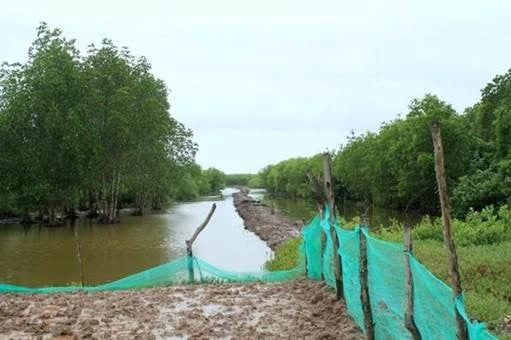
It is not often that I get to connect Youtube videos, tabloid headlines, and a study tour to the Republic of Korea to a project I am working on, especially when it involves improving connectivity for the poorest minorities in the furthest parts of Vietnam, such as the Mekong delta.
Vietnam’s temporary monkey bridges are not your ‘normal’ problem. Made of locally available materials such as bamboo, rope, and wood, have long been the mainstay for rural communities – often ethnic minorities – living in the remote sections of the Mekong Delta. Though sometimes tourists romanticize them – as this Youtube video shows – even in the best of times they add considerably to the hardships of life in the delta. Moreover, they do not offer even this minimal level of service year round. As this article and video illustrates – when the river is in spate – more dramatic solutions are often necessary. You’ll see this family crossing the river where the father puts the kids in a plastic bag and carries them across the river so they can go to school.
While improving these bridges has long been a development priority; the challenge has been to find solutions that are cost-effective. The remoteness of the area and the often scattered nature of the bridges has just increased the challenge. But in 2014 the Minister of Transport personally asked the World Bank to partner with the Government of Vietnam to help solve the problem of the monkey bridges. The government’s National Program for Eradicating Temporary Bridges (NPETB) consists of 4,145 bridges scattered across 50 of Vietnam’s provinces. The World Bank has committed to support the installation of just over half of those bridges (2174) via the Results-Based Operation for Local Bridge Construction and Road Management (LRAMP) loan.
And indeed, today I feel somewhat confident that we are close to a solution, thanks to two kinds of innovations. The first, a process innovation in World Bank lending instruments has provided flexibility to innovate and try different kinds of solutions. The LRAMP loan is organized as a Program for Results (P4R); an instrument that supports a broad program – in this case a program to replace the monkey bridges with acceptable permanent bridges – and disburses against results achieved, in this case the number of bridges actually built. This is quite different from traditional lending instruments that finance particular contracts procured in particular ‘approved’ ways - which are most useful when methods and materials are standard, and well understood. The P4R facilitates the innovation a development problem such as this one demands, and in this case fits well with the government of Vietnam’s search for innovative cost-effective solutions.
The second exciting innovation leads us to South Korea. Last month I joined a study tour, organized by the Korea Green Growth Trust Fund (KGGTF), to Korea to learn from the country’s experience with developing clean and resilient transport systems. Meeting with research institutes was an important element of the trip and that is the context in which we met with the Korean Institute for Construction Technology (KICT). KICT works primarily on methods and materials associated with road systems. They got me excited by talking about their experiments with Ultra High Performance Concrete (UHPC) and their assessment that UHPC could actually be a cost-effective solution for Vietnam’s monkey bridges. It turns out that Vietnam’s Ministry of Construction in consultation with the Ministry of Transport had independently identified UHPC as a promising solution and thus had started a conversation with KICT. Under normal circumstances – UHPC’s high strength translates to a significantly higher cost of construction. Savings in material used and lifecycle costs (it requires much less maintenance than regular concrete) compensate adequately for the construction cost premium only in specialized cases. But it turns out that replacing monkey bridges in the remote Mekong delta may well be one of those specialized cases! The relatively light UHPC components can be constructed off-site and transported to the location where the bridges are needed; a big advantage when the goal is to replace temporary bridges scattered across a remote landscape. The reduced need for maintenance is additional bonus!
I returned from Korea with more immediate and tangible benefits then I had ever expected and we are now working with Vietnam’s Ministry of Transport and KICT to design a pilot to rigorously evaluate the feasibility of using UHPC bridges in the context of the congoing LRAMP project. We will know in a few months if the economics and practicality of UHPC works out as we hope it will. For now, we have the makings here of a real ‘leapfrog’ example – where a cutting edge technology being tested in the research institutes of a donor OECD country has immediate applications in solving here-to intractable problems of accessibility that have systematically excluded many in the Mekong delta from sharing in Vietnam’s development gains of the last few decades. If all goes well – I can report back in a few months confident that plastic bags and monkey bridges can be permanently relegated to the past; though we promise to leave some for the tourists to enjoy!
| Ultra-High Performance Concrete or UHPC is a revolutionary material known for its high strength, durability and reduced weight, being deployed for multiple purposes in the transport sector. UHPC is structurally more comparable to steel than it is to traditional concrete – as a result, significantly less material (-70%) is needed to achieve the same structural requirements. This leads to a much lower weight, less substructure when used as a façade, as well as lower shipping and installation costs. In addition, because UHPC does not contain the capillary pores of traditional precast or glass-reinforced concrete, it does not absorb water and degrade in demanding weather or marine conditions. – TAKTL |


Join the Conversation